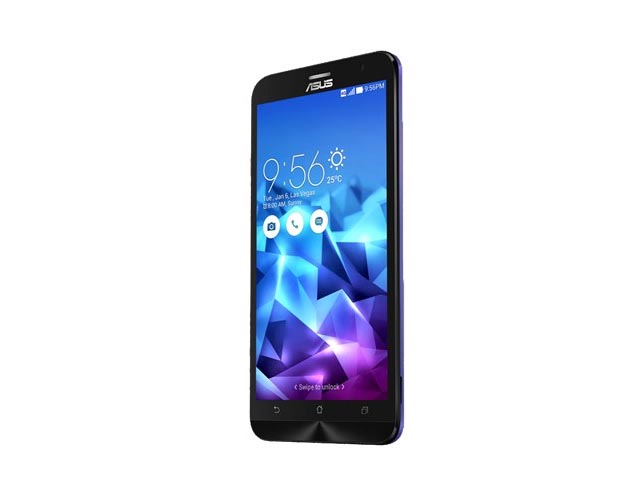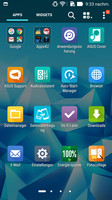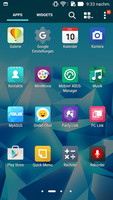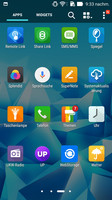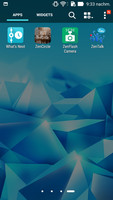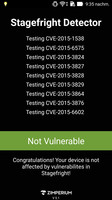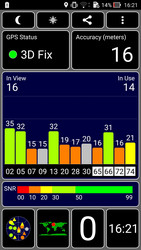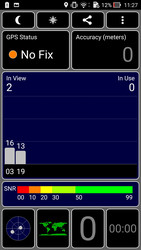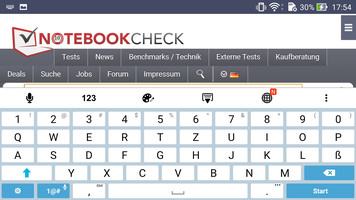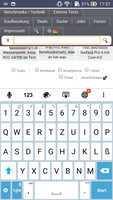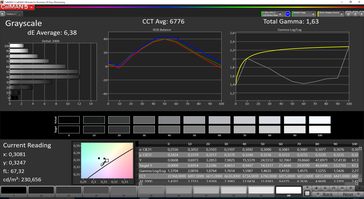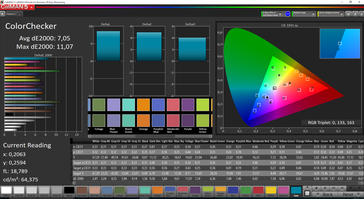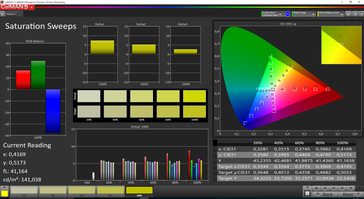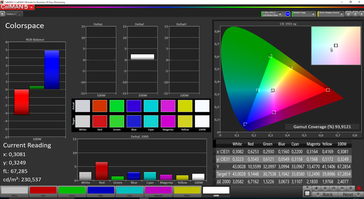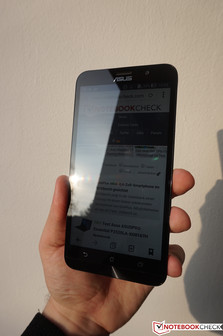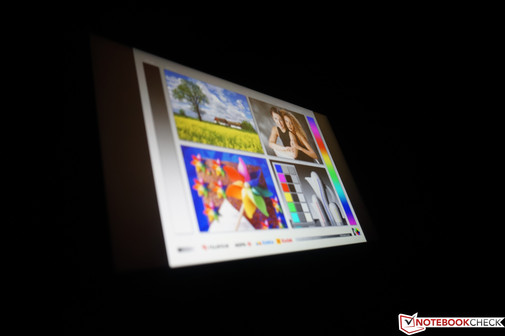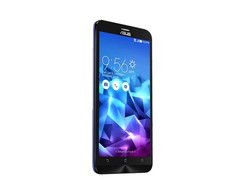Asus ZenFone 2 Deluxe ZE551ML Smartphone Review
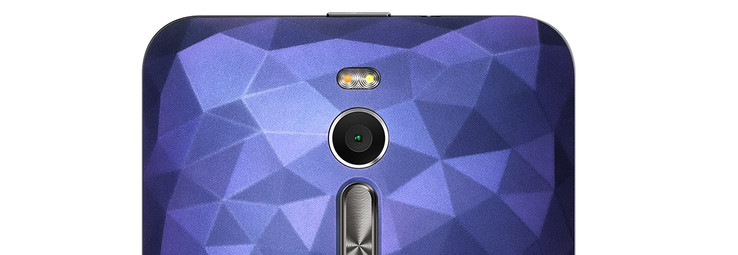
For the original German review, see here.
The ZenFone 2 Deluxe is the high-end smartphone from Asus and with its unusual design aims to attract customers. Moreover, at a first glance, the features of the 5.5-inch smartphone are also decent and there are even some real highlights like the huge 128 GB of storage as well as the quad-core processor from Intel plus 4 GB of RAM. Other interesting aspects are the dual-SIM function, storage expansion via microSD and a camera that is also supposed to take good pictures in low-light conditions.
Our review unit retails for 499 Euros (~$545) and competes with other flagship devices. These include the Motorola Moto X Style, the Huawei Mate S, the LG G4 or the Samsung Galaxy S6, for example.
Case
The chassis construction reminds us of the familiar ZenFone 2, but the manufacturer uses a new back cover with a 3D design consisting of 500 polygonal areas instead of the smooth surface. This does indeed look very appealing, even though the effect was a bit subtle in the case of our white review unit (Illusion White). You can also get a blue (Illusion Blue) or pink model if you prefer a more noticeable finish. Despite the new pattern, however, the back cover is only made of pretty simple plastic, which can be noticed when you touch it. In general, the stability leaves a decent impression; there is only some slight creaking.
The maximum height of 10.9 millimeters (~0.43 in) is pretty well-concealed by the rounded back cover. The thickness is even reduced to just 3.9 millimeters (~0.15 in) on the two sides, so there is no room for physical buttons. The power button is now at the top (center) and the volume rocker is located at the back. The handling of the latter cannot impress us, because it is slightly loose and creates a rather loud clicking sound. The back cover can be removed, although it requires some force. However, you only gain access to the two SIM slots (both micro) and the additional slot for microSD-cards. This means that you need not forgo a storage expansion when you use two SIM cards, but unfortunately the battery is not replaceable.
Connectivity
Asus uses a quad-core SoC from Intel, more specifically the Atom Z3580, with a maximum clock of 2.33 GHz. It is supported by an enormous 4 GB of RAM and files can be stored on the 128 GB internal storage. You can also expand the storage via microSD-card by up to 128 GB and compatible apps can be transferred to the microSD card after installation. At the bottom of the smartphone is a Micro-USB 2.0 port, which can be used to charge the device and synchronize files with a PC. UST-OTG is supported as well and our USB flash drive was immediately recognized via an adapter. MHL or Miracast are not available, data transfers in local networks are only possible via Chromecast. Data transfers to other mobile devices are possible via Bluetooth 4.0 and NFC.
Software
Asus ships the ZenFone 2 Deluxe with Android 5.0 and its own user interface ZenUI. The functionality is not really that different from standard Android, but there are some additional features. This does, for example, include ZenMotion, where you can accept a call by holding the smartphone to your ear. The manufacturer was pretty generous with additional software. These include some useful tools, but also unnecessary bloatware. You can see all the preloaded apps on the screenshots below. The Android buttons are implemented as sensor buttons below the display and do not occupy any space on the display, but unfortunately they are not illuminated.
Communication & GPS
Unlike many other mobile SoCs, the chip from Intel does not include a modem, so the manufacturer had to integrate an additional module. The ZenFone 2 Deluxe even gets two additional modules for the dual-SIM feature, where both cards can be used at the same time. The first SIM slot is handled by the modem XMM 6262, which supports up to LTE Cat. 4 (downstream 150 Mbps, upstream 50 Mbps). It also covers a lot of frequencies (see specifications at the beginning of the review), so you should get a signal in many parts of the world.
The second SIM slot can only be used for calls in the 2G network. The Intel XMM 2230 modem also supports Bluetooth 4.0 and the FM radio (in combination with a headset). The signal quality was inconspicuous in the metropolitan T-Mobile network.
Local wireless connections are handled by another module, which is not specified. It supports the standards 802.11 a/b/g/n/ac in 2.4 as well as 5 GHz networks. The connection with the two routers Asus RT AC56U and Fritz!Box 7490 was flawless and there were no unexpected signal losses or other issues.
The position of the smartphone can be located via A-GPS and GLONASS. The location was not possible indoors, not even close to a window. The process only took a few seconds outdoors, but the accuracy was just 16 meters (~52 ft). Some comparison devices are much more accurate in this regard.
Telephone & Voice Quality
The Phone app is very simple and dominated by the large numbers pad. You also get access to favorites, contacts and groups. In addition, it is possible to create VIP contacts or see a history of calls from blocked contacts.
The voice quality was decent with both SIM-slots. Voices were easy to understand on both sides of the call and there were only slight distortions (quiet static) from time to time. The position of the speaker can be an issue when you use the hands-free feature, when the smartphone is lying on a table or even worse, a soft object (pillow, blanket), when the voice of the caller will be muffled.
Cameras & Multimedia
At the back of the ZenFone 2 Deluxe is a 13 MP camera (f/2.0, autofocus) that takes pictures with up to 4096x3072 pixels. The quality of the pictures is actually decent, because the colors are vivid and you can see many details. Asus also advertises the PixelMaster technology, which is supposed to ensure better results in low-light situations. The brightness is actually pretty good in these scenarios, but there is visible picture noise, so many details will be lost.
You can immediately notice the lower resolution of the front camera at 5 MP, and the pictures are also pretty dark. However, the quality is sufficient for selfies. Overall, the ZenFone 2 Deluxe offers many settings and picture modes.
Videos can be recorded in Full HD and you can also create slow motions as well as time lapses.
Accessories
The ZenFone 2 Deluxe comes with a modular 10-watt power adapter (5V, 2A), a USB cable, a headset, a manual as well as a warranty card. Asus also offers additional accessories on its homepage. They are primarily designed for photographers, because besides an external professional Xenon flash (Zenflash), you can also get a dual-LED flash called Lolliflash. Its shape is similar to a lollipop and it can be easily attached to the stereo jack. You can choose between different filters to improve selfies. Asus also offers special in-ears (ZenEar, ZenEar S) as well as an external battery (ZenPower).
Warranty
The warranty period is 24 months.
Input Devices & Handling
The default input is the Asus keyboard. It offers the common functions like swipe inputs and word predictions. You can also adjust the height of the keyboard to a certain extent. The capacitive touchscreen provides good gliding capabilities and executes inputs reliably and without delays. The handling was always smooth.
Display
Asus has equipped the ZenFone 2 Deluxe with a 5.5-inch IPS display. The resolution is 1920x1080 pixels, which results in a pixel density of 400 PPI. Individual pixels are therefore not visible and the subjective picture impression is very good with sharp pictures and fonts. We can measure an average luminance of almost 395 cd/m², which is comparatively low. The brightness distribution of 88% is not perfect, but there are no restrictions in practice.
The black value is pretty high at 0.5 cd/m², which is typical for an IPS display. This also means that the contrast ratio is "only" 850:1. Only the Motorola Moto X Style is even worse in the comparison, while the LG G4 and the two AMOLED based devices, the Samsung Galaxy S6 and the Huawei Mate S have an advantage.
| |||||||||||||||||||||||||
Brightness Distribution: 88 %
Center on Battery: 425 cd/m²
Contrast: 850:1 (Black: 0.5 cd/m²)
ΔE ColorChecker Calman: 7.05 | ∀{0.5-29.43 Ø4.77}
ΔE Greyscale Calman: 6.38 | ∀{0.09-98 Ø5}
Gamma: 1.63
CCT: 6776 K
| Asus Zenfone 2 Deluxe ZE551ML PowerVR G6430, Z3580, 128 GB eMMC Flash | Motorola Moto X Style Adreno 418, 808 MSM8992, 32 GB eMMC Flash | Huawei Mate S Mali-T628 MP4, Kirin 935, 32 GB eMMC Flash | LG G4 Adreno 418, 808 MSM8992, 32 GB eMMC Flash | Samsung Galaxy S6 Mali-T760 MP8, Exynos 7420, 32 GB UFS 2.0 Flash | |
|---|---|---|---|---|---|
| Screen | 20% | -0% | 19% | 18% | |
| Brightness middle (cd/m²) | 425 | 538 27% | 352 -17% | 566 33% | 335 -21% |
| Brightness (cd/m²) | 395 | 528 34% | 350 -11% | 536 36% | 345 -13% |
| Brightness Distribution (%) | 88 | 92 5% | 87 -1% | 90 2% | 89 1% |
| Black Level * (cd/m²) | 0.5 | 0.66 -32% | 0.47 6% | ||
| Contrast (:1) | 850 | 815 -4% | 1204 42% | ||
| Colorchecker dE 2000 * | 7.05 | 2.63 63% | 4.95 30% | 6.17 12% | 2.51 64% |
| Greyscale dE 2000 * | 6.38 | 3.24 49% | 6.54 -3% | 6.26 2% | 2.59 59% |
| Gamma | 1.63 135% | 2.17 101% | 2.27 97% | 2.48 89% | 2.43 91% |
| CCT | 6776 96% | 6906 94% | 6943 94% | 8171 80% | 6424 101% |
| Color Space (Percent of AdobeRGB 1998) (%) | 65.48 | ||||
| Color Space (Percent of sRGB) (%) | 98.63 |
* ... smaller is better
The ZenFone 2 Deluxe does not leave a good impression in the other measurements with the professional software CalMAN and is usually in the last place within the comparison group. The average DeltaE deviation compared to the sRGB reference color space is 7.05 for the colors and 6.38 for the grayscale. The target values would be smaller 3 in both cases. The gamma value is also too low at 1.62 (ideal: 2.2). Subjectively, we cannot see a strong blue cast, but Asus still provides a blue light filter in the quick settings that uses a slightly warmer color temperature.
The visibility of the glossy display is very good outdoors as long as you can avoid direct light sources. You should also activate the automatic brightness control in bright environments to benefit from the highest possible luminance. The viewing angle stability of the IPS screen is good, the contrast will only drop from extreme angles and you can see a slight gray hue.
Performance
Asus offers two versions of the ZenFone 2 Deluxe, although the availability varies based on the region. The two models differ in terms of the processor and storage capacity. While the quad-core processor (Z3580) of our review unit can reach up to 2.33 GHz, the smaller version with the Z3560 is limited to 1.8 GHz. The less powerful model also has a smaller storage capacity of 64 GB.
The general performance of our review unit is decent. Extensive multitasking benefits from the 4 GB of RAM in particular and is not a big challenge. The benchmarks show that the Atom processor (64-bit) of our review unit is usually just beaten by the Snapdragon 808 in the LG G4 and the Motorola Moto X Style, while the Exynos 7420 of the Galaxy S6 is usually out of range. The PowerVR G6430 performs better in the benchmarks and battles with the Galaxy S6 for the first place. The other comparison devices are sometimes clearly beaten.
The internal storage with a capacity of 128 GB is not one of the fastest flash modules. Many rivals are already faster in the sequential tests (read 144 MB/s, write 89 MB/s), but the performance is only sufficient for the last place in the random tests (read 20.6 MB/s, write 8.48 MB/s). It can therefore take a little longer when you copy larger files, but there should not be any limitations.
The subjective performance was sufficiently high to ensure a smooth operation all the time. Web browsing also convinces without stutters.
| AnTuTu v5 - Total Score (sort by value) | |
| Asus Zenfone 2 Deluxe ZE551ML | |
| Motorola Moto X Style | |
| Huawei Mate S | |
| LG G4 | |
| Samsung Galaxy S6 | |
| Geekbench 3 | |
| 32 Bit Multi-Core Score (sort by value) | |
| Asus Zenfone 2 Deluxe ZE551ML | |
| LG G4 | |
| Samsung Galaxy S6 | |
| 32 Bit Single-Core Score (sort by value) | |
| Asus Zenfone 2 Deluxe ZE551ML | |
| LG G4 | |
| Samsung Galaxy S6 | |
| 64 Bit Multi-Core Score (sort by value) | |
| Motorola Moto X Style | |
| Huawei Mate S | |
| LG G4 | |
| 64 Bit Single-Core Score (sort by value) | |
| Motorola Moto X Style | |
| Huawei Mate S | |
| LG G4 | |
| GFXBench 3.0 | |
| on screen Manhattan Onscreen OGL (sort by value) | |
| Asus Zenfone 2 Deluxe ZE551ML | |
| Motorola Moto X Style | |
| Huawei Mate S | |
| LG G4 | |
| Samsung Galaxy S6 | |
| 1920x1080 1080p Manhattan Offscreen (sort by value) | |
| Asus Zenfone 2 Deluxe ZE551ML | |
| Motorola Moto X Style | |
| Huawei Mate S | |
| LG G4 | |
| Samsung Galaxy S6 | |
| Smartbench 2012 | |
| Gaming Index (sort by value) | |
| Asus Zenfone 2 Deluxe ZE551ML | |
| Motorola Moto X Style | |
| Huawei Mate S | |
| LG G4 | |
| Productivity Index (sort by value) | |
| Asus Zenfone 2 Deluxe ZE551ML | |
| Motorola Moto X Style | |
| Huawei Mate S | |
| LG G4 | |
| Linpack Android / IOS | |
| Multi Thread (sort by value) | |
| Asus Zenfone 2 Deluxe ZE551ML | |
| Motorola Moto X Style | |
| Huawei Mate S | |
| LG G4 | |
| Single Thread (sort by value) | |
| Asus Zenfone 2 Deluxe ZE551ML | |
| Motorola Moto X Style | |
| Huawei Mate S | |
| LG G4 | |
| GFXBench (DX / GLBenchmark) 2.7 | |
| T-Rex Onscreen (sort by value) | |
| Asus Zenfone 2 Deluxe ZE551ML | |
| Motorola Moto X Style | |
| Huawei Mate S | |
| LG G4 | |
| Samsung Galaxy S6 | |
| 1920x1080 T-Rex Offscreen (sort by value) | |
| Asus Zenfone 2 Deluxe ZE551ML | |
| Motorola Moto X Style | |
| Huawei Mate S | |
| LG G4 | |
| Samsung Galaxy S6 | |
| Sunspider - 1.0 Total Score (sort by value) | |
| Asus Zenfone 2 Deluxe ZE551ML | |
| Motorola Moto X Style | |
| Huawei Mate S | |
| LG G4 | |
| Samsung Galaxy S6 | |
| Octane V2 - Total Score (sort by value) | |
| Asus Zenfone 2 Deluxe ZE551ML | |
| Motorola Moto X Style | |
| Huawei Mate S | |
| LG G4 | |
| Samsung Galaxy S6 | |
| Mozilla Kraken 1.1 - Total (sort by value) | |
| Asus Zenfone 2 Deluxe ZE551ML | |
| Motorola Moto X Style | |
| Huawei Mate S | |
| LG G4 | |
| JetStream 1.1 - Total Score (sort by value) | |
| Asus Zenfone 2 Deluxe ZE551ML | |
| Motorola Moto X Style | |
| Huawei Mate S | |
| LG G4 | |
| Samsung Galaxy S6 | |
* ... smaller is better
Games
Thanks to the good graphics performance of the PowerVR G6430, the ZenFone 2 Deluxe can also handle games very well. Even the demanding “Asphalt 8: Airborne” can be played at the highest settings, although the gameplay is only completely smooth at medium details. Simpler games like “Angry Birds 2” are therefore obviously no problem. The sensors work well, but you can quickly cover the speaker at the back with your hands.
Emissions
Temperature
The overall temperature development of the ZenFone 2 Deluxe is not critical. There are already some spots that warm up to 33 °C (~91 °F) while idling, but the average value is a comfortable 31 °C (~88 °F). The warming is primarily focused on the upper part of the device, where we can measure up to 39 °C (~102 °F) during the stress test. This is still not inconvenient and the temperatures will hardly be that high in practice.
(+) The maximum temperature on the upper side is 37.9 °C / 100 F, compared to the average of 35.2 °C / 95 F, ranging from 21.9 to 247 °C for the class Smartphone.
(+) The bottom heats up to a maximum of 39.3 °C / 103 F, compared to the average of 34 °C / 93 F
(+) In idle usage, the average temperature for the upper side is 31 °C / 88 F, compared to the device average of 32.9 °C / 91 F.
Speakers
At the back of the smartphone is one speaker, which does a pretty good job. The maximum volume is sufficiently high and you can still listen to it when you crank it up. As expected, bass is not available, but the sound is pretty balanced. You also get the Asus AudioWizard with several profiles. A better result is possible via headphones or external speakers, which can be attached via a stereo jack or Bluetooth.
Energy Management
Power Consumption
The power consumption of the smartphone is slightly high compared to the rivals. One possible reason is the two additional modems, which are already integrated into the SoCs of the other models, but the differences are not extreme. The power adapter has a nominal output of 10 watts and has no problems to cover the maximum consumption of the ZenFone 2 Deluxe.
| Off / Standby | |
| Idle | |
| Load |
|
Key:
min: | |
| Asus Zenfone 2 Deluxe ZE551ML PowerVR G6430, Z3580, 128 GB eMMC Flash | Motorola Moto X Style Adreno 418, 808 MSM8992, 32 GB eMMC Flash | Huawei Mate S Mali-T628 MP4, Kirin 935, 32 GB eMMC Flash | LG G4 Adreno 418, 808 MSM8992, 32 GB eMMC Flash | Samsung Galaxy S6 Mali-T760 MP8, Exynos 7420, 32 GB UFS 2.0 Flash | |
|---|---|---|---|---|---|
| Power Consumption | 11% | 24% | -5% | 35% | |
| Idle Minimum * (Watt) | 1.1 | 0.7 36% | 0.6 45% | 1.1 -0% | 0.4 64% |
| Idle Average * (Watt) | 2.2 | 2.2 -0% | 1.2 45% | 1.5 32% | 0.6 73% |
| Idle Maximum * (Watt) | 2.4 | 2.3 4% | 1.6 33% | 1.9 21% | 1.2 50% |
| Load Average * (Watt) | 4.2 | 3.9 7% | 4.1 2% | 6.6 -57% | 5 -19% |
| Load Maximum * (Watt) | 7.2 | 6.8 6% | 7.4 -3% | 8.8 -22% | 6.8 6% |
* ... smaller is better
Battery Runtime
Our review unit is equipped with a 3000 mAh battery (lithium-polymer) that manages a runtime of 7 hours in our Wi-Fi test, where we simulate the web browsing at an adjusted brightness of 150 cd/m². This is an average result within our comparison, because the Huawei S Mate and the Galaxy S6 have more stamina, while both the LG G4 as well as the Motorola Moto X Style have to be recharged sooner.
The ZenFone 2 Deluxe also offers different energy-saving modes to increase the runtimes. This includes the normal energy-saving mode and a super-saving mode, but it is also possible to adjust the settings manually. The smartphone supports QuickCharge and Asus even sells a special 18-watt PSU (BoostMaster) for our test model with the faster Atom processor (Z3580).
| Asus Zenfone 2 Deluxe ZE551ML PowerVR G6430, Z3580, 128 GB eMMC Flash | Motorola Moto X Style Adreno 418, 808 MSM8992, 32 GB eMMC Flash | Huawei Mate S Mali-T628 MP4, Kirin 935, 32 GB eMMC Flash | LG G4 Adreno 418, 808 MSM8992, 32 GB eMMC Flash | Samsung Galaxy S6 Mali-T760 MP8, Exynos 7420, 32 GB UFS 2.0 Flash | |
|---|---|---|---|---|---|
| Battery runtime | -4% | 37% | -23% | 13% | |
| WiFi v1.3 (h) | 7 | 6.7 -4% | 9.6 37% | 5.4 -23% | 7.9 13% |
| WiFi (h) | 9.6 |
Pros
Cons
Verdict
At the beginning of the test, we raised the question whether the Asus ZenFone 2 Deluxe is a convenient package. The answer is yes, because there are no real drawbacks. But let us have a look at the positive aspects first. The highlight of the ZenFone 2 Deluxe is certainly the generous memory equipment. 4 GB of RAM and 128 GB of storage should be sufficient for the coming years. Another highlight is the dual-SIM support with the simultaneous storage expansion via microSD-card.
You have to look quite hard to find some issues. The back cover is nicely designed, but only made of simple plastic. The volume rocker of our device was wobbly and not well-integrated. The battery is fixed, even though you can remove the back cover. The display could also produce more accurate colors, but in practice, this should not be a big deal for many users.
However, none of these issues are really serious. The biggest problem is probably the average performance in many sections, because the review unit can only stand out from the competition in terms of memory capacity. However, if you like the design of the ZenFone 2 Deluxe, there is no reason why you should not buy it.
The ZenFone 2 Deluxe from Asus is a good smartphone that does not offer many highlights, but there are no serious drawbacks in any area, either.
Asus Zenfone 2 Deluxe ZE551ML
- 01/04/2016 v4 (old)
Andreas Osthoff


